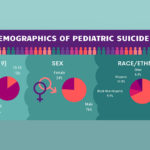When a friend dies by suicide: Preventing suicide contagion

Suicide can shake an entire community. For some kids, a friend or classmate’s suicide increases the risk that they may resort to the same behavior. This risk, known as suicide contagion, can affect people who lived down the street from the person who died, went to school with them, or simply saw them around town.
“After suicide, the person’s closest friends aren’t necessarily the ones at greatest risk,” says Kimberly O’Brien, clinical social worker in the Department of Psychiatry and Behavioral Sciences at Boston Children’s Hospital. “The kids at greatest risk are the ones who are already emotionally vulnerable and those who believe their classmate solved their problems through suicide.” O’Brien is also co-author of Emotionally Naked: A Teacher’s Guide to Preventing Suicide and Recognizing Students at Risk with Anne Moss Rogers.
Here, O’Brien and Boston Children’s psychologist Erica Lee talk about how a classmate’s suicide can affect children and teens and ways parents can help their kids process their feelings.
Risk of contagion in the aftermath of suicide
Any death, particularly a death by suicide, brings up a wide range of feelings: shock, sorrow, anger, and guilt, to name a few. While there’s no right or wrong way to feel, some kids are more vulnerable to suicide contagion than others. “If a kid is already struggling with depression, anxiety, or suicidal thoughts, a classmate’s suicide can exacerbate those thoughts and feelings,” says Lee.
The way people talk about suicide can also increase other students’ risk. For instance, the more details about how the person took their life are made public, the greater the risk that other students may engage in similar behavior.
To reduce such risk, parents and school officials can take a cue from the news media’s suicide reporting guidelines. The voluntary guidelines aim to reduce the chance of suicide contagion by:
- not focusing on the method or location of suicide
- not speculating what event or person may have triggered the suicide
- not suggesting suicide is an understandable response to difficult feelings
This is not to say that parents should try to gloss over a classmate’s death. “Parents should not try to keep the suicide a secret from their kids,” says O’Brien. “You don’t want to focus on the method of death, but don’t take away from the loss of this person by not doing or saying anything.”
Self-care for parents in the wake of suicide
It’s only natural for parents to have a strong reaction when a child dies by suicide. Ignoring such emotions in an effort to appear strong can backfire. “Kids often monitor their parents for signs of distress,” says Lee. “If they think their parent is upset, they might hide their thoughts and feelings rather than upset their parent more.”
Taking time to process their emotions also gives parents a chance to think about what they want to say and how they want to say it, adds Lee. “The conversation may be hard to have, but approaching it in a calm, open frame of mind can reassure your child you will work through this together.”
Open communication to reduce kids’ risk of suicide
O’Brien suggests that parents check in frequently with their child after a classmate’s death by suicide. “A kid might feel fine one day, then it may hit them the next day.” Conversations should leave room for children to explore their feelings about the person who died, suicide, and their own experiences.
Open communication also includes asking kids if they have suicidal thoughts. “Many parents worry that asking a child if they think about harming themself may ‘plant’ the idea in their mind,” says Lee. It doesn’t. By asking the question, parents let children know it’s OK to talk about scary feelings.
Tips for talking with tweens and teens about the death of a classmate by suicide
- Use clear, straightforward language and leave plenty of room for your child to express their thoughts and feelings.
- Open the conversation with questions. For instance, ‘What have you heard about what happened?’ and ‘How are you feeling about what happened?’
- Focus on the fact that the person who died had a psychiatric illness that made it hard for them to think clearly.
- Avoid judging the person who died or the people close to them. No single event causes suicide.
- Be ready to hear what your child is thinking and feeling. Remember, everyone responds differently to suicide.
- Offer reassurance. Most people with suicidal thoughts get support that helps them find other ways to cope with emotional pain.
If your child tells you they think about harming themself, feel hopeless, or is in overwhelming emotional pain, seek help from a mental health professional. If you believe your child is in immediate danger, call 911 or bring your child to the closest emergency room.
Honoring the person who died
Grieving after suicide can be complicated. “It’s important that kids have a way to honor their friend or classmate without reinforcing the idea that dying is a way to gain attention or love,” says Lee.
“To reduce other students’ risk, the emphasis should be on suicide prevention,” adds O’Brien. She suggests working with an organization like the American Foundation for Suicide Prevention to help raise awareness about suicide. Kids can also participate in a fundraiser like an Out of the Darkness Walk or volunteer for a crisis hotline. Any of these activities can help kids acknowledge a classmate’s death while learning about suicide prevention.
If you or your child is in crisis, call the National Suicide Prevention Lifeline at 1-800-273-TALK (8255), or contact the Crisis Text Line by texting HOME to 741741.
Related Posts :
-

Talking with your child about suicide
For three weeks in late spring of 2018, it seemed like suicide dominated the media. On May 18, the second season of ...
-

Suicide prevention in teens: Can we intervene through primary care?
The past year has seen a disturbing rise in suicidal thoughts and attempts among adolescents, with a spike of suicidal ...
-

Poverty associated with suicide risk in children and adolescents
Suicide in children under age 20 has been increasing in the U.S., with rates almost doubling over the last decade. ...
-

Firearm suicides in children and youth: A state-by-state look
At a time when mental health problems are skyrocketing, a new study provides one of the most comprehensive state-by-state accountings ...





